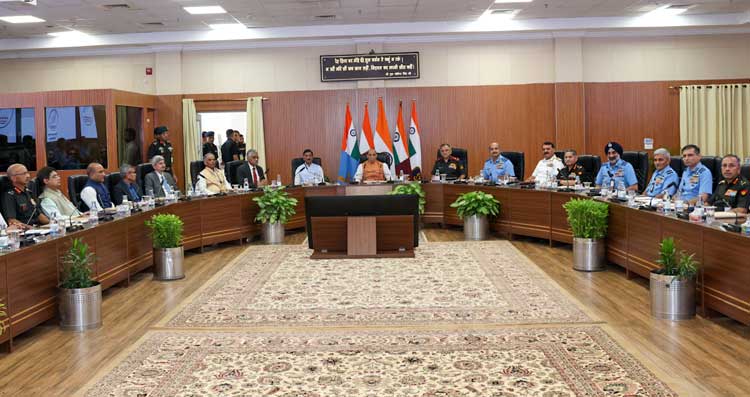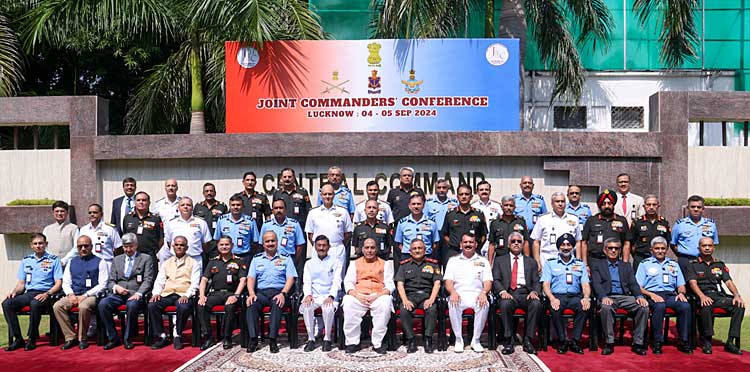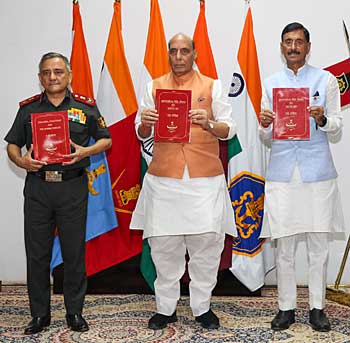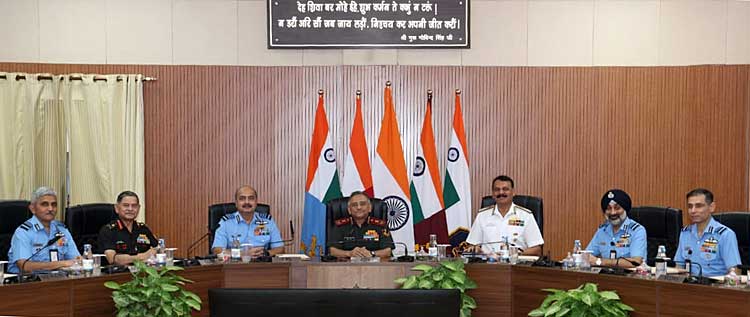INDIAN ARMED FORCES CHIEFS ON OUR RELENTLESS AND FOCUSED PUBLISHING EFFORTS

The insightful articles, inspiring narrations and analytical perspectives presented by the Editorial Team, establish an alluring connect with the reader. My compliments and best wishes to SP Guide Publications.

"Over the past 60 years, the growth of SP Guide Publications has mirrored the rising stature of Indian Navy. Its well-researched and informative magazines on Defence and Aerospace sector have served to shape an educated opinion of our military personnel, policy makers and the public alike. I wish SP's Publication team continued success, fair winds and following seas in all future endeavour!"

Since, its inception in 1964, SP Guide Publications has consistently demonstrated commitment to high-quality journalism in the aerospace and defence sectors, earning a well-deserved reputation as Asia's largest media house in this domain. I wish SP Guide Publications continued success in its pursuit of excellence.
Theaterisation on Anvil
The broad theaterisation plan includes a Northern Theatre Command for the China border, a Western Theatre Command for the Pakistan border, and a Maritime Theatre Command for the Indian Ocean Region
 |
The Author is Former Director General of Information Systems and A Special Forces Veteran, Indian Army |

24 years after the government-appointed Kargil Review Committee (KRC) and the Group of Ministers (GoP) recommended military theaterisation, its implementation appears on the anvil although the final nod of the government is still awaited.
The blueprint for the proposed Theatre Commands was presented at the Joint Commanders Conference (JCC) held at Headquarters, Central Command in Lucknow on September 4 and 5, attended by Defence Minister Rajnath Singh. The theme of the conference was 'Sashakt aur Surakshit Bharat: Transforming the Armed Forces'.
The blueprint for the proposed Theatre Commands was presented at the Joint Commanders Conference, which focused on transforming the Armed Forces in the face of regional and global volatility
A statement issued by the Ministry of Defence (MoD) before the JCC said that the conference will factor in the prevailing volatility in the regional and global environments to deduce plausible operational and employment scenarios, and simultaneously undertake threat and resource matching to develop a robust concept for future wars; providing an opportunity for the commanders to review modernisation plans of the Armed Forces and discuss ways to improve the nation's defence capability through jointness and enhanced synergy among the three Services.

Addressing the JCC on September 5, Chief of Defence Staff (CDS) General Anil Chauhan stressed on enhancing integration across various domains to adapt to the contours of future warfare and conduct of effect-based operations. With the three Services initiating measures on the roadmap to integration, he said this was a step-by-step process, beginning with cross-service cooperation, leading to a joint culture and finally achieving integration of forces to conduct joint operations.
The broad theaterisation plan, as reported in the media, includes the following:
- Northern Theatre Command responsible for the China border with HQ at Lucknow;
- Western Theatre Command responsible for the Pakistan border with HQ at Jaipur;
- Maritime Theatre Command responsible the Indian Ocean Region (IOR) with HQ at Thiruvananthapuram.
According to official sources, it will take 12-18 months for the Theatre Commands to take concrete shape on the ground after the final approval by the government.
The proposal reportedly also includes the following:
- all three Theatre Commanders to be of four-star rank;
- establishment of post of Vice CDS with four-star rank;
- existing HQ Central Command to be relocated elsewhere than Lucknow;
- the Army's South Western Command and Southern Air Command of the Indian Air Force will get subsumed in the Theatre Commands;
The plan will require accretion and rebalancing of manpower for setting up cyber, space and underwater sub-commands.
According to a senior defence ministry official, all the three Theatre Commanders will have 'operational' roles and they must be on par with the Service Chiefs for decision-making. While Theatre Commanders will handle operational security, the role of the Service Chiefs will be limited to raise-train-sustain and other administrative functions.
It will take 12-18 months for the Theatre Commands to take shape after the government's final approval, with all three Theatre Commanders being of four-star rank and having operational roles

In accordance with the recommendations of the KRC after the 1999 Kargil conflict, the Andaman & Nicobar (A&N) Command (ANC) was established in 2001 and the Strategic Forces Command (SFC) in 2003, as also the CDS, that was established in January 2020. Subsequently, the Armed Forces Special Operations Division (AFSOD), Defence Cyber Agency (DCyA) and the Defence Space Agency (DSA) were established in 2019. The proposal of an Air Defence Command was deliberated and abandoned.
The setting up of Theatre Commands was under discussion over the past few years. Theaterisation received a setback under the first CDS when he publicly called the IAF a "supporting arm". Also, the post of the CDS remained vacant for one year after the first CDS died in an air crash before the government appointed a second CDS.
China recently broke up its Strategic Support Force (SSF), reconstituting it into three components; PLA's Aerospace Force, PLA's Cyber Space Force and PLA's Information Support Force. Some analysts in India are of the view that it will take at least three years, if not more, for these forces to stabilise for effectiveness if major disruptions in the South China Sea and Taiwan don't take place. Therefore, they cite this as a golden opportunity and a strategic window for India to theaterise its Armed Forces.
The proposal faces challenges, including concerns over the lack of a National Security Strategy (NSS) and unresolved issues with command structures between the Army and other security forces
But why would China take three years to fully stabilise these three components while we take 12-18 months to establish and operationalise our Theater Commands? Moreover, China is assiduously practicing the takeover of Taiwan and clash with the US, which implies it possibly stabilised these components before officially establishing them or are doing so "on the move", This is what India would also need to do; expecting a window without hostilities would be foolish.

Ironically, the Theaterisation Plan is being affected, subject to the government approval, in the absence of a National Security Strategy (NSS). Are we putting the cart before the horse or will the NSS be enunciated before the government approves the theaterisation? The CDS earlier stated that India does not need a "written NSS", which possibly was to save the government accountability. But if that was the case, why did the government officially task the National Security Advisor to chalk out a NSS in 2019?
The erstwhile perception of India facing a dual-front threat has undergone a drastic change. China has drawn Nepal and Myanmar deeper into its strategic sphere and has established dual-use military villages inside Bhutan. India's waning influence in wake of the regime change in Bangladesh has turned to China's advantage with protesters in that country openly calling for balkanising India and the Chinese Ambassador in Dhaka meeting the Al Qaeda head of Bangladesh. To top this, the US appears intent on destabilising India and promoting an India-China war.
India's evolving strategic environment, including growing Chinese influence in Nepal, Myanmar, and Bangladesh, demands a more holistic assessment of future threats beyond just China and Pakistan
The utilisation of central IAF assets was under discussion as a hindrance to theaterisation. At the same time, employment of Army's dual-tasked formations, as well as central reserves, also needs closer examination. In a situation where operations are underway in both the Eastern and Western Theatres, and the Bangladesh border also activated, the Army's dual-tasked formations would get fully committed and possibility of criticalities arising simultaneously in both theatres cannot be discounted altogether.
Continued pruning of Army's manpower must take into account that we may be fighting a prolonged war. Also, according to the media, the boundary between the Eastern and Western Theatre Commands is to run from Indira Col in the north along the Saltoro Range. The Siachen Brigade faces the threat both from Pakistan and China, which needs to be factored in. The boundary between the two theatre commands should not split the area of responsibility of the Siachen Brigade.
At the cost of reiterating, the immediate need is to address future threats holistically, for which defining the NSS and undertaking a comprehensive defence review (CDR) are essential. The Defence Minister's Annual Directive is a generic document which hardly meets the requirement. The holistic threat assessment must also take into account threats from across our borders with Nepal, Bhutan, Myanmar and Bangladesh (not China-Pakistan only) considering the dynamics of the region and future portends. Prudence lies in examining the worst case scenario in the NSS and the CDR; otherwise we may end up reacting to enemy actions piecemeal.
Finally, while the need is of effect-based operations, as elucidated by the CDS, in our case the Army is not integrated into the Border Infrastructure Management Authority (irrespective of which force is manning which border) and the ITBP deployed on the border with China is not even under the command of the Army, whereas, China's Border Guard Divisions are directly under the PLA. This must be addressed by the government.





